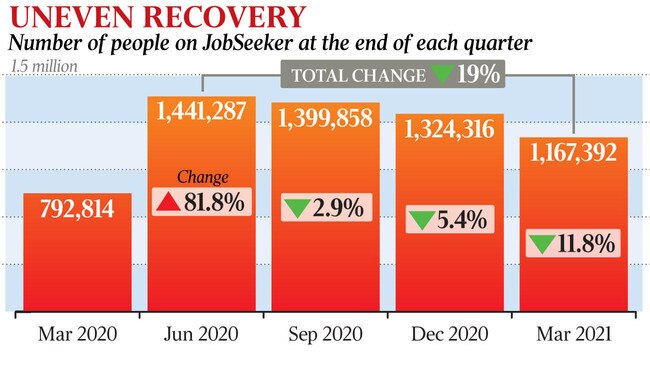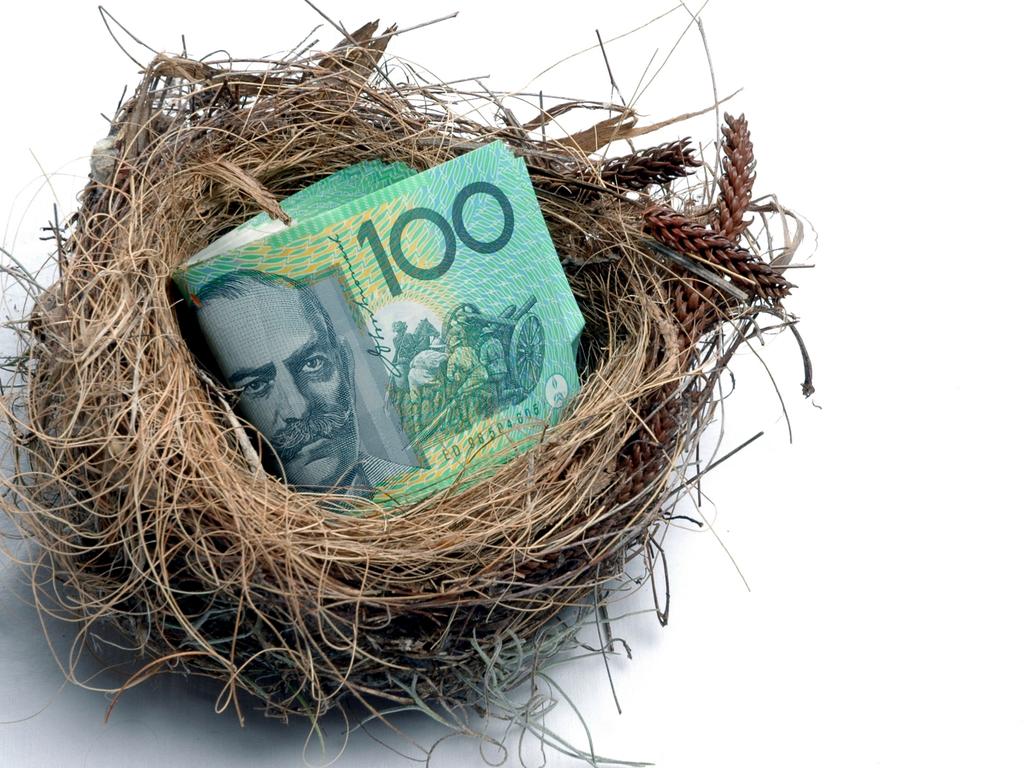An economic rebound for post-Covid ages
Consumer confidence is at a 12-year high, shares are trading at pre-pandemic levels and job ads are at their best levels in two decades.

Australia’s burst of economic buoyancy is continuing with consumer confidence hitting a 12-year high, shares trading at pre-pandemic levels and job advertisements at their best levels in two decades.
Less than four weeks from the federal budget being handed down, unemployment figures to be released on Thursday are expected to fall again, confirming the strong post-pandemic rebound and increasing confidence that the end of JobKeeper payments last month will not cause an economic setback.
The benchmark ASX 200 index closed above 7000 points for the first time since the pandemic began after the release of the strong consumer confidence indicators.
Economists are optimistic that Thursday’s labour force figures will show strong jobs growth, with the Commonwealth Bank forecasting unemployment would fall to 5.7 per cent for March.
Belinda Allen, a CBA economist, said cashed-up consumers were now “in a sweet spot”.
With consumer optimism flying high and businesses reporting the best operating conditions on record, economists have been caught out by the pace of the post-pandemic recovery.
In an update released on Wednesday, National Australia Bank economists said they now expected unemployment to fall to 5.1 per cent by the end of the year, and to decline to 4.7 per cent over the following 12 months before reaching 4.4 per cent by the end of 2023.
The key jobless measure has already dropped by 1.2 percentage points over the four months to February — the fastest decrease in that timeframe in the history of Australian Bureau of Statistics figures stretching back to 1978.
As the pace of the recovery continues to surpass predictions, the Reserve Bank’s forecasts from its February Statement on Monetary Policy — in which the bank’s economists estimated unemployment would still be 6 per cent by the end of this year, and 5.5 per cent by December next year — appear too pessimistic.

The end of JobKeeper remains the greatest source of uncertainty for the labour market with Treasury predicting up to 150,000 jobs may be lost in its wake.
However, in the first major reading of the national mood post the end of the wage subsidy, the Westpac-Melbourne Institute consumer sentiment index jumped 6.2 per cent to 118.8 in April, the highest since August 2010 as households expressed “considerable” optimism about the trajectory of the economy and their future financial situations.
Westpac chief economist Bill Evans described the result as “extraordinary” in the context of delays to the government’s vaccine rollout, and given JobKeeper ended in the week before the survey was undertaken.
“Initial fears that (the end of JobKeeper) and associated job losses would undermine confidence have proven to be unfounded,” Mr Evans said.
The national survey of 1200 households was conducted between April 5 and April 10.
On the evening of April 8, Scott Morrison released advice that the AstraZeneca vaccine would not be rolled out to those under the age of 50 in a major setback for the government’s health strategy. Yet, consumer confidence has proved “resilient” to the bad news, Mr Evans said.
The size of the blow from the end of the wage subsidy will be evident in the April and May statistics, but upbeat indicators of future labour demand have buoyed hopes the impact will be offset by strong jobs growth.
New data from Seek showed March recorded the highest number of job ads in the company’s 23-year history.

Postings surged 10 per cent in the month, led by trades and services, healthcare and medical, and hospitality and tourism jobs — the last leaping by 35 per cent.
However, sectors such as hospitality have reported significant difficulties in finding workers as restrictions ease and operations ramp up. The Seek data showed that while the number of ads in March was unprecedented, the proportion of applicants per ad was the lowest since 2012.
There are roughly as many people employed now as before the pandemic — a significantly better than anticipated outcome only a year after COVID arrived in Australia. Underemployment, at 8.5 per cent, also has returned to pre-pandemic levels, while total hours worked are just 0.7 per cent lower than in March last year.
Compared with other advanced economies, Australia’s jobs recovery looks remarkable. Employment is at around 70 per cent of pre-pandemic levels in the US and at 90 per cent in Canada.
The number of JobSeeker recipients, however, remains stubbornly above pre-pandemic levels, although Australians are dropping off support at an increasing pace, according to analysis of Department of Social Services figures.
The number of JobSeeker recipients surged by 80 per cent in the June quarter of last year to more than 1.44 million as health restrictions forced businesses to shut their doors and lay off staff.
That number fell by under 5 per cent in the following two quarters before declining by a larger 12 per cent in the March quarter to 1.17 million recipients — above the fewer than 800,000 before the pandemic.
A breakdown of JobSeeker figures by electorate reveals a large difference across the nation in terms of what percentage of jobs lost at the height of the pandemic have been clawed back.
The 21 electorates with the smallest percentage reduction in JobSeeker recipients are all in NSW, including the whole of western Sydney, while the 10 electorates with the biggest recovery are all in Western Australia.
The uneven nature of the labour market recovery, if sustained, could have ramifications at the ballot box. Safe Labor seats such as Blaxland, Chifley and Werriwa had the slowest recovery with only 20 per cent fewer JobSeeker recipients at the end of March compared with the peak of the pandemic.
Several marginal Coalition seats that could be crucial to the Morrison government’s survival hopes have also fared poorly.
Liberal-held Reid, in Sydney’s inner west and held on a margin of 3.2 per cent, saw its JobSeeker recipient total jump from 2479 at the end of the March quarter last year to 7796 by the end of June. Only about a third of that increase has been clawed back since the June quarter, DSS figures show, versus a national average of 42 per cent.
Lindsay, in the city’s far west, is a marginal seat held by the Liberals on a margin of 5 per cent. The jobs clawback in that electorate is fewer than three out of 10.
In Melbourne, Chisholm, the Coalition’s most marginal seat after a redistribution reduced its margin to just 0.2 per cent, has lagged most of the rest of the Victorian capital, clawing back 40 per cent of the initial COVID-related increase in JobSeeker numbers.







To join the conversation, please log in. Don't have an account? Register
Join the conversation, you are commenting as Logout